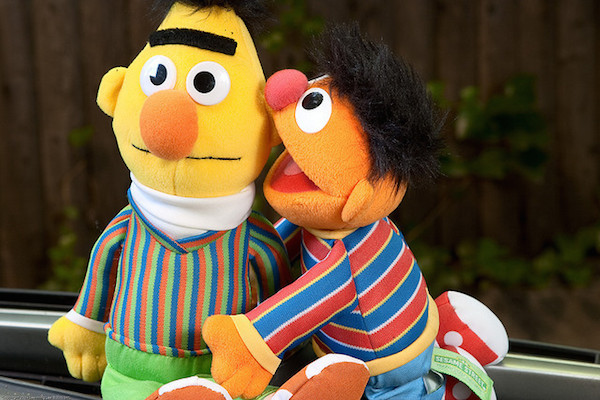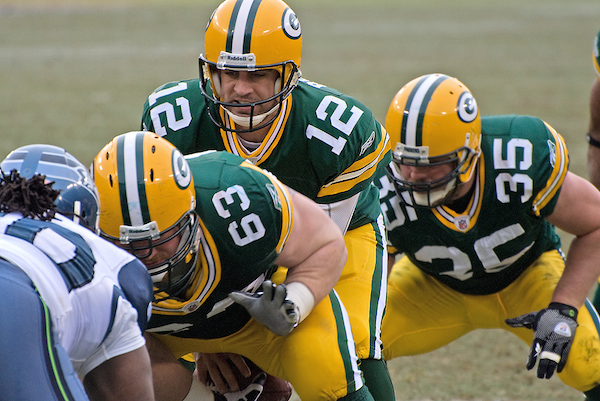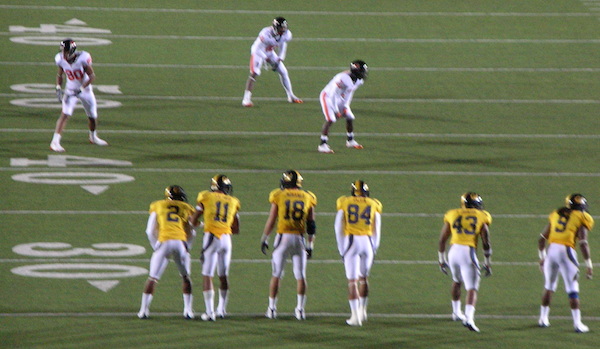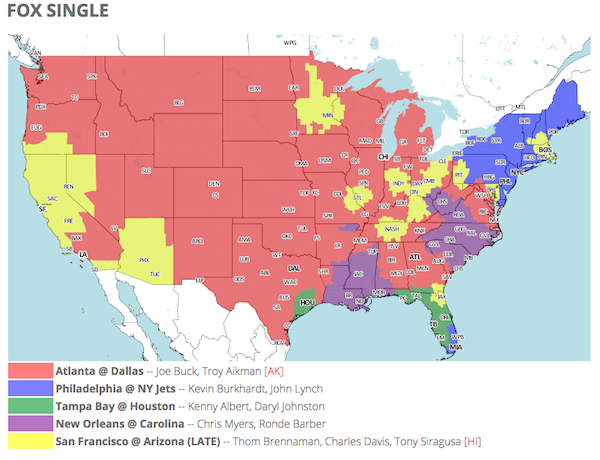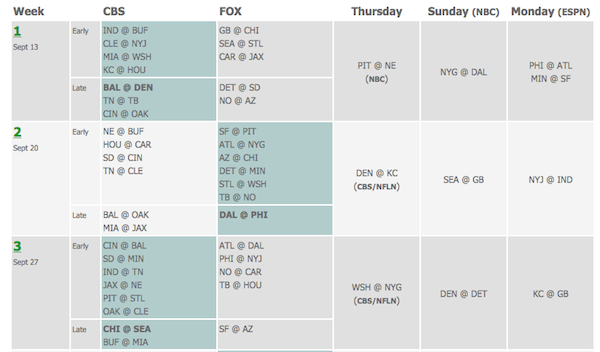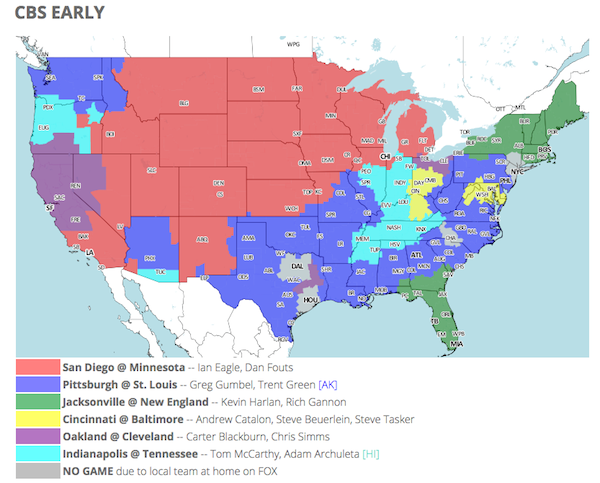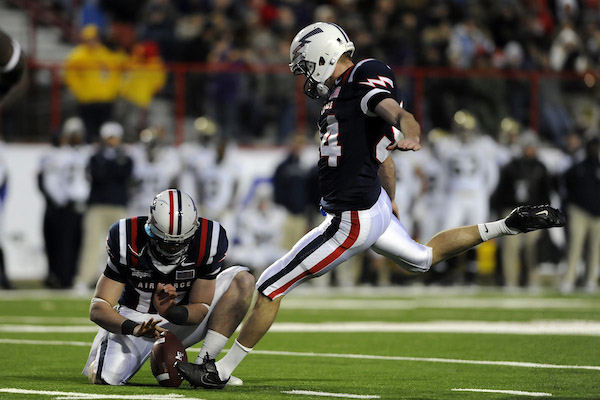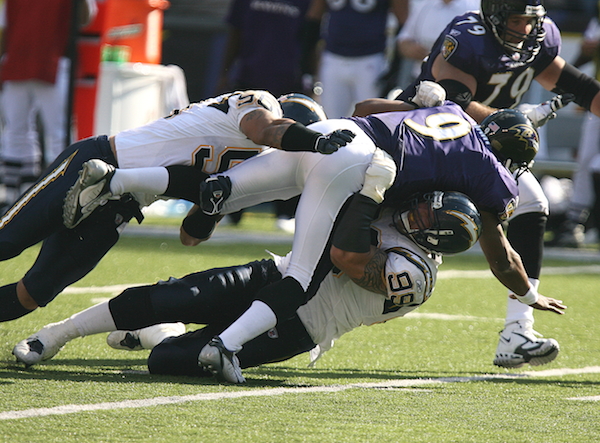Hello everyone and welcome to America’s favorite game show that… has never actually happened before and no one has heard of it… it’s Pitch That Game!
Here’s how it works. As your host, I have one minute to pitch a sporting event to someone who is not a sports fan. If, after my pitch, they’re interested in watching, I get a point! That’s it! Why would we play such a game? Well, it’s a good way to quickly learn about a set of games to see if you’re interested in following any of them. It’s also a great way for me to learn from you about what may or may not make a sport interesting to a layperson.
In this episode, I pitch you, the listener, all 14 of the NFL games this weekend, on Sunday October 4 and Monday October 5. If you want to know which games will be available on your TV this weekend, check out 506 Sports NFL. If you need help figuring out how to make sense out of what you see there, use my explanation of how to use 506 Sports NFL here.
Enjoy the show!
Sunday, October 4, 2015 9:30 a.m. ET
New York Jets at Miami Dolphins
This game is novel just for its location and time. It’s in London and because of that, it starts at 9:30 a.m. ET. This makes a very civilized way to start the day if you’re on the East Coast. Sit down with your breakfast and morning paper or head out for bottomless Bloody Marys and brunch! Either way, it’s kind of fun to watch football in the morning. Of course, if you’re on the West Coast, this game becomes something else entirely. If you wake up at 6 a.m. to watch the Jets play the Dolphins, you’ve got a serious problem. As for the game itself, no team has been more disappointing this year than the Dolphins. The word trickling through cyberspace is that the players don’t like their coach, Joe Philbin. If the team loses today, he could get fired on Monday.
Sunday, October 4, 2015 1 p.m. ET
New York Giants at Buffalo Bills
Bills fans and even just generally pro-Bills observers are waiting to exhale once they get a sign that these promising Bills are different from other years. The Bills often get off to fast starts only to wilt. This year seems different. This team beat the Colts and Dolphins, two teams we thought were good but that have not played well yet this season. The Bills only loss was to the Patriots, who seem like they might not lose a game this year. If this version of the Bills is really good, they’ll beat the Giants and you’ll hear a lot of exhalations of relief around the country.
Carolina Panthers at Tampa Bay Buccaneers
Tampa Bay Buccaneers quarterback Jameis Winston is probably hoping his career will turn into the kind of redemption story that Cam Newton’s has. Both were maligned for “character flaws” coming into the league. The difference is — Cam Newton’s character flaws were over whether he and his family had been paid for his college football career. Winston’s? Winston’s are over the likely sexual assault in his past. Different stories with, I hope, different endings. It may not make you want to watch the game, but I’m going to keep bringing it up and rooting for the Buccaneers to lose until Winston is out of the league.
Oakland Raiders at Chicago Bears
Similar to the Giants vs. Bills game, this game should provide final confirmation of an up-and-coming team’s legitimacy. The problem with the Raiders seeking legitimacy from beating the Bears is that the Bears may actually be too bad to provide any feedback at all. The Chicago Bears are such a mess this year that their general manager started trading players to other teams for future draft picks. That kind of thing happens frequently in other sports but almost never in the NFL, especially not after three weeks. This puts the Raiders in an awkward position. No one will pat them on the back if they beat Chicago but people will certainly make fun of them if they don’t.
Kansas City Chiefs at Cincinnati Bengals
Kansas City has been enjoying a minor sports renaissance over the past few years. For the Chiefs, it started with the arrival of coach Andy Reid from Philadelphia and quarterback Alex Smith from San Francisco. It may be over. Last week’s loss to the Green Bay Packers had all the signs of a team that’s about to cycle through a vicious cycle of blame. The way that works in football is that the quarterback gets blamed first and then the coach and then the general manager. Quarterback Alex Smith will be the first to go and perhaps he should be. His play last week had people scrambling to their computers to see who the team’s backup quarterback was. Another clunker this week and we might all get to know Chase Daniel, college star at Missouri and long-time New Orleans Saints backup, very very well.
Houston Texans at Atlanta Falcons
The plot of this game should be all about the matchup between the incredible Falcons offense and the impenetrable Texans defense. Those units are certainly where the star power on both sides is. Alas, the Texans defense haven’t really shown much impenetrability this year as the team’s 1-2 record reflects. It’s probably safe to assume the Falcons, who have been great on offense, will score some points on the Texans. That pushes the pivotal element of the story over to the other side of the ball where a struggling Houston offense that may improve with the return of their leading rusher, Arian Foster, faces a young Falcons defense that is likely to improve as the season goes on.
Jacksonville Jaguars at Indianapolis Colts
This game could be the most meaningful game of the weekend. The Jaguars are a relatively new franchise, only about 20 years old, and for almost all of their existence they’ve been tortured by the Indianapolis Colts. First the Colts had Peyton Manning, a near unbeatable quarterback, and then, as soon as he left, they got Andrew Luck, another near unbeatable quarterback. In that time, the Jaguars have cycled through many, many quarterbacks, most of whom turned out to be… uh… eminently beatable. The Jaguars franchise, except for a brief blip in the late 1990s, have been a laughingstock — an example of futility. Well, this year, they have been showing signs of earning respectability at least. If the Jaguars could beat the Colts, which seems unlikely but possible to me, it would be a potentially franchise changing win, at least in how people view the Jaguars.
Philadelphia Eagles at Washington Redskins
This game has a variety of interesting sub-plots. First – Philadelphia’s coach, Chip Kelly, and their press department, seem to have decided this week not to refer to the Washington Redskins by their name. This is a hot-button issue because many people, including a majority of Redskins fans, I believe, think the name is racist and should be changed. Washington’s team owner disagrees and so far has refused to consider it. Second – there may be a hurricane hitting the East Coast just as this game begins. Football prognosticators often warn that bad weather doesn’t change a game as much as one would think but I don’t think a hurricane fits into that description. From my perspective, there’s nothing better than watching football in bad weather… from my couch. As for the stakes of the game, they’re pretty big. With the other two teams in the Eagles and Redskins’ division struggling, it seems like an 8-8 record might get a team into the playoff. When you’re expecting so few wins in a division, it magnifies every victory, especially one like this where a victory for you means a defeat for another team in the division.
Sunday, October 4, 2015 4:05 or 4:25 p.m. ET
Cleveland Browns at San Diego Chargers
One of the greatest fallacies in sports is that the better the teams involved, the better the game will be. It’s simply not true. Sometimes you have two great teams that play each other and it’s completely boring. That won’t be a problem in this game. These two teams are bad. But they’re interestingly bad. The Chargers have a very good quarterback in Phillip Rivers but literally four of their starting five offensive linemen didn’t practice on Friday because they’re all injured. A great quarterback can be made to look pedestrian if he plays behind a bad offensive line. Rivers might just look like he’s scrambling for his life. The Browns on the other hand… well, basically their entire team reportedly isn’t happy with their coaches decision to go with the, perhaps more competent, but certainly less exciting quarterback on their roster, Josh McCown instead of Johhny Manziel. As long as McCown is in the game, the Browns are aiming for a solid B-. With Manziel, they’ll either get an A or an F with no in between. Who knows, perhaps Manziel will get a shot in this game — it will certainly be interesting to watch if he does.
Minnesota Vikings at Denver Broncos
The Broncos defense, one of the best, if not the best in the league, will present Vikings sophomore quarterback Teddy Bridgewater with his biggest test yet. I enjoyed watching Bridgewater in college — he has a calm, in control way about him that’s easy to root for, so I hope he passes the test with flying colors. As for the Broncos side of the ball, this is the fourth time we get to see quarterback Peyton Manning play for coach Gary Kubiak. Manning has spent most of his career in charge of every element of what his offense is doing. That’s unique in today’s NFL. This season, he’s had to adjust to a coach who wants to do their own thing on offense and has the support of management to make it happen. It’s been totally fascinating to watch the offense evolve each week as the theoretically collaborative power struggle between coach and quarterback continues. My guess is that they’ll find a happy and winning middle ground.
Green Bay Packers at San Francisco 49ers
If you want to see evidence of the great influence a coach has in the NFL, look no farther than the dramatic change in the plot of a matchup between these two teams. Just a few years ago, the 49ers were the team that frustrated the Packers like no other. The 49ers traveled to Lambeau Field in Green Bay and knocked the Packers out of the playoffs. 49ers quarterback Colin Kaepernick was the next big thing – a player with limitless potential. Now the 49ers are 1-2 and people are openly wondering whether the team will bother to pick up Kaepernick’s option for next season. Meanwhile, the Packers remain one of the most stable and successful teams in the league. There’s very little doubt about the outcome of this game but very little doesn’t mean none. It’ll be worth watching, even just for the visual spectacle of seeing the 49ers traditional red and gold opposite the Packers even more traditional green and yellow.
St. Louis Rams at Arizona Cardinals
Virtually no one thinks the Rams have much of a shot in this game. The Cardinals have burst out of the gate this season and look like one of the best three teams in the league. They’re undefeated and tough to play at home in Arizona. The Rams, on the other hand, are 1-2 and looking classically shabby, like the Rams often do. I won’t deny any of that… but I just have a feeling that we could be missing the boat on this one. The Rams often play well in divisional games, which this one is, no matter how bad they are and how good their divisional opponent is. For evidence, we need look no farther than their Week One victory over the Seattle Seahawks. The Rams are also best at exploiting what the Cardinals are worst at. The Rams have a scarily good defensive line and the Cardinals are ever so slightly questionable on offensive line. The Cardinals would never do this, but if I were them, I’d be tempted to pull injury plagued and essential quarterback Carson Palmer out of the game at the least provocation.
Sunday, October 4, 2015 8:30 p.m. ET
Dallas Cowboys at New Orleans Saints
This is not what the NFL schedulers had in mind when they put this game on national television. They couldn’t imagine that the Cowboys would be without their best two players on offense or that the Saints would be winless on the year. On the other hand those losses amplify the importance of this game. It’s virtually a playoff game for the Saints and in Week Four, that is actually about as compelling as a scheduler could imagine. Talk about tripping into success. Nice job NFL schedulers!
Monday, October 5, 2015 8:30 p.m. ET
Detroit Lions at Seattle Seahawks
This game seems like a tough sell. An 0-3 team playing a 1-2 team? Ugh. Forget about the records though and it has all the component needed for an exciting game. The Detroit Lions have one of the most fantastic offensive players in NFL history in wide receiver Calvin Johnson. 6’5″ tall and as fast as a gazelle, he’s a potent weapon. Standing across from him on virtually every play will be Richard Sherman, the leader of a daunting Seattle Seahawks defense, and himself one of the most smotheringly frustrating-to-play against defensive players in the league. That one on one matchup, best against best, will be worth the price of admission. Okay, just looked at StubHub and the cheapest seats available are around $160. So, maybe not worth that, but worth turning your TV on and watching, for sure.

